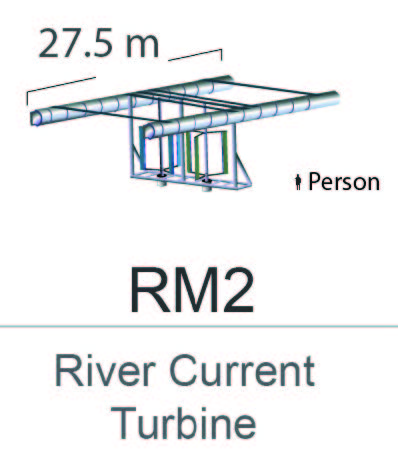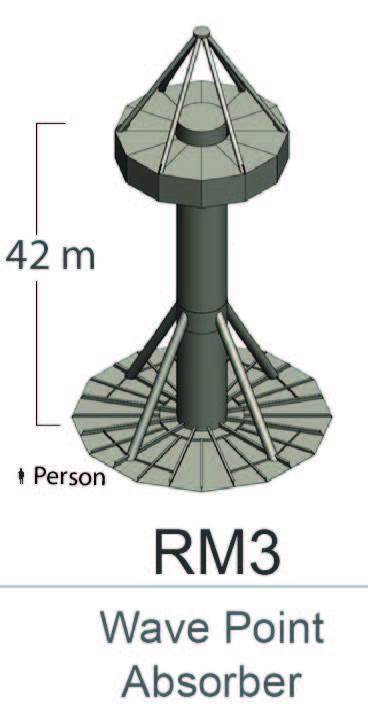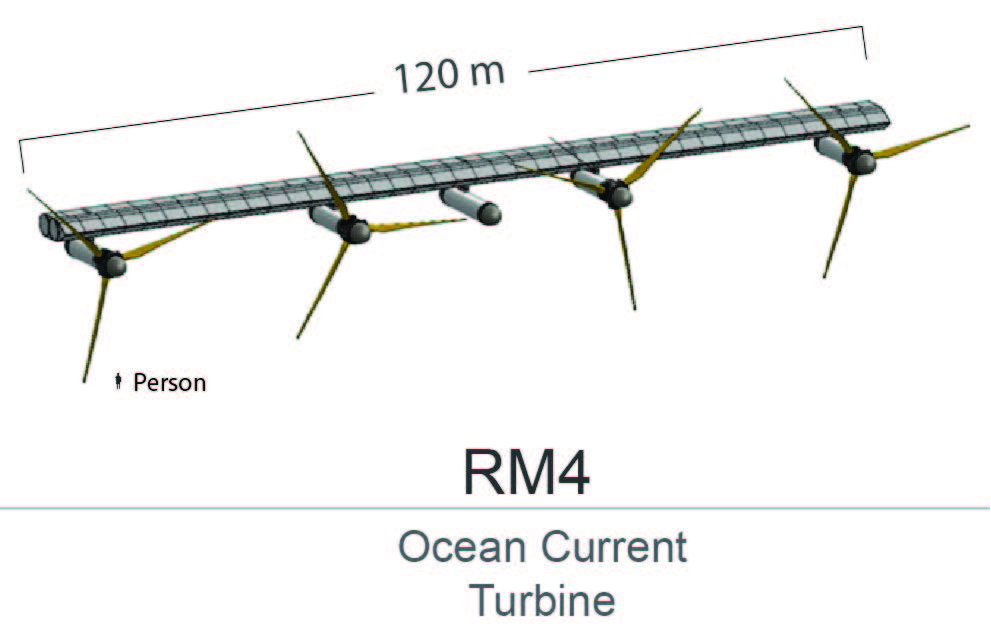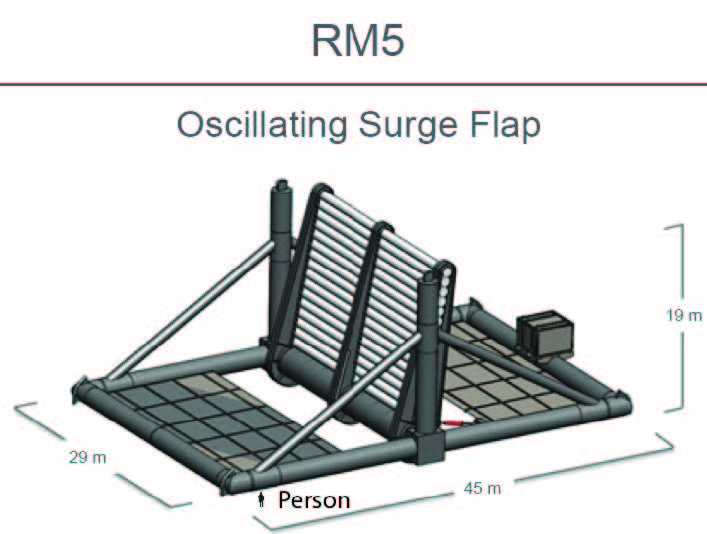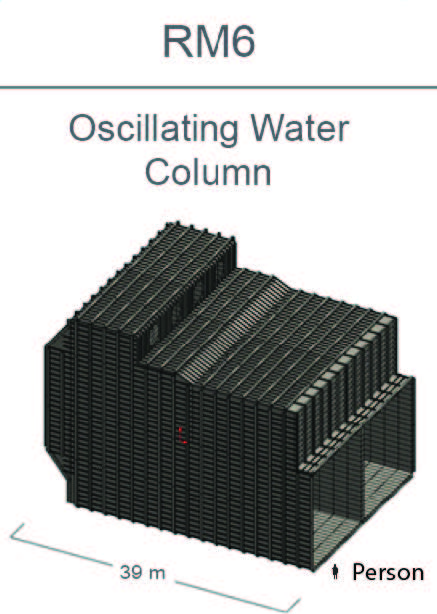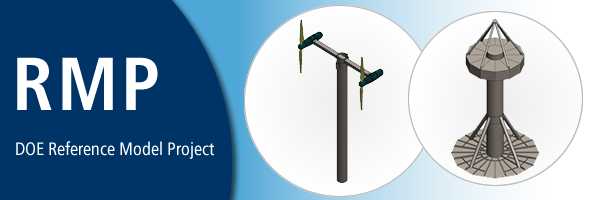
The Reference Model Project (RMP), sponsored by the U.S. Department of Energy (DOE), was a partnered effort to develop open-source marine hydrokinetic (MHK) point designs as reference models (RMs) to benchmark MHK technology performance and costs, and an open-source methodology for design and analysis of MHK technologies, including models for estimating their capital costs, operational costs, and levelized costs of energy. The RMP project team, led by Sandia National Laboratories (SNL), included a partnership between DOE, three national laboratories, including the National Renewable Energy Laboratory (NREL), Pacific Northwest National Laboratory (PNNL), and Oak Ridge National Laboratory (ORNL), the Applied Research Laboratory of Penn State University, and Re Vision Consulting.
The six reference models illustrated below were developed:
Click images to enlarge.
Downloads, Related Studies, and Supporting Documentation
Open-source research products for these reference models are available for download below. Along with supporting documentation, these products facilitate research and development (R&D) studies by industry, academia, and national laboratories. These products include:
- A detailed methodology for design and analysis of MHK devices and estimation of capital and operational costs, and levelized cost of energy (LCOE);
- Design specifications and SolidWorks™ geometry files for each reference model device to allow exact replication for physical and numerical modeling studies;
- Reference resource site information for designing MHK devices;
- Physical model data sets for validating design modeling tools;
- Spreadsheets with cost breakdown structures for calculating the LCOE for single devices and multiple unit arrays;
- Logic models that provide environmental compliance requirements and methods for estimating their costs.
RMP products are also intended to be used by other MHK stakeholders such as government agencies to inform decision making and permitting-process development.
Reference Model Documents Download
Please complete the form below to download the Reference Model Documents. These are collected for reporting purposes to our sponsor.
Reference Model Documents Download
Please complete the form below to download the Reference Model Documents. These are collected for reporting purposes to our sponsor.
"*" indicates required fields
Fact Sheet
Neary, Vincent (2015). DOE Reference Model Project. SAND2019-6109 M
Reports
V. Neary, M. Previsic, R. Jepsen, M. Lawson, Y. Yu, A. Copping, A. Fontaine, K. Hallett, D. Murray (2014). Methodology for Design and Economic Analysis of Marine Energy Conversion (MEC) Technologies. SAND2014-9040
V. Neary, B. Gunawan, C. Michelen, A. Fontaine, P. Bachant, M. Wosnik, B. Straka, R. Meyer (2013). US Department of Energy (DOE) National Lab Activities in Marine Hydrokinetics: Scaled Model Testing of DOE Reference Turbines. SAND2013-7241
A.E. Copping, S.H. Geerlofs (2011). The Contribution of Environmental Siting and Permitting Requirements to the Cost of Energy for Marine and Hydrokinetic Devices.
M. Previsic (2011). Economic Methodology for the Evaluation of Emerging Renewable Technologies
Main Report
V. Neary, M. Previsic, R. Jepsen, M. Lawson, Y. Yu, A. Copping, A. Fontaine, K. Hallett, D. Murray (2014). Methodology for Design and Economic Analysis of Marine Energy Conversion (MEC) Technologies. SAND2014-9040
Reference Site Resource
Brian Polagye (2012). Reference Model 1–Tidal Energy: Resource
Performance
G. Bir, M. Lawson, Y. Li (2011). Structural Design of a Horizontal-axis Tidal Current Turbine Composite Blade
M.J. Lawson, Y. Li, D.C. Sale (2011). Development and Verification of a Computational Fluid Dynamics Model of a Horizontal-axis Tidal Current Turbine
Structural Analysis
Refer to: V. Neary, M. Previsic, R. Jepsen, M. Lawson, Y. Yu, A. Copping, A. Fontaine, K. Hallett, D. Murray (2014). Methodology for Design and Economic Analysis of Marine Energy Conversion (MEC) Technologies, SAND2014-9040.
Power Conversion Chain Design
Mike J. Beam, Brian I. Kline, William Straka, Arnold A. Fontaine, Michael Lawson, Ye Li, Robert Thresher, Mirko Previsic (2012). Marine Hydrokinetic Turbine Power-Take-Off Design for Optimal Performance and Low Impact on Cost-of-Energy
Experimental
C. Hill, V. S. Neary, B. Gunawan, M. Guala, F. Sotiropoulos (2014). U.S. Department of Energy Reference Model Program RM1: Experimental Results. SAND2014-18783R.
Environmental
Refer to: V. Neary, M. Previsic, R. Jepsen, M. Lawson, Y. Yu, A. Copping, A. Fontaine, K. Hallett, D. Murray (2014). Methodology for Design and Economic Analysis of Marine Energy Conversion (MEC) Technologies
Cost & Economic
Mirko Previsic (2012). Reference Model 1 Cost Breakdown Structure for Tidal Current Device
3D CAD Geometry Files
(2014) RM1 SolidWorks Files. SAND2014-3092W.
Main Report
Refer to: V. Neary, M. Previsic, R. Jepsen, M. Lawson, Y. Yu, A. Copping, A. Fontaine, K. Hallett, D. Murray (2014). Methodology for Design and Economic Analysis of Marine Energy Conversion (MEC) Technologies
Reference Site Resource
V. Neary (2011). Reference Inflow Characterization for River Resource Reference Model: Reference Model 2 (RM2)
Performance
M. Barone, T. Griffith, J. Berg (2011). Reference Model 2: ‘Rev 0’ Rotor Design. SAND2011-9306.
P. Bachant, M. Wosnik1, B. Gunawan, V. Neary (2016). Experimental Study of a Reference Model Vertical-Axis Cross-Flow Turbine.
Structural Analysis
Refer to: V. Neary, M. Previsic, R. Jepsen, M. Lawson, Y. Yu, A. Copping, A. Fontaine, K. Hallett, D. Murray (2014). Methodology for Design and Economic Analysis of Marine Energy Conversion (MEC) Technologies
Power Conversion Chain Design
Refer to: V. Neary, M. Previsic, R. Jepsen, M. Lawson, Y. Yu, A. Copping, A. Fontaine, K. Hallett, D. Murray (2014). Methodology for Design and Economic Analysis of Marine Energy Conversion (MEC) Technologies
Mooring Design
Refer to: V. Neary, M. Previsic, R. Jepsen, M. Lawson, Y. Yu, A. Copping, A. Fontaine, K. Hallett, D. Murray (2014). Methodology for Design and Economic Analysis of Marine Energy Conversion (MEC) Technologies
Experimental
Craig Hill, Vince Neary, Budi Gunawan, Michele Guala, Fotis Sotiropoulos (2014). U.S. Department of Energy Reference Model Program RM2: Experimental Results. SAND2014-16561R.
Environmental
Refer to: V. Neary, M. Previsic, R. Jepsen, M. Lawson, Y. Yu, A. Copping, A. Fontaine, K. Hallett, D. Murray (2014). Methodology for Design and Economic Analysis of Marine Energy Conversion (MEC) Technologies
Cost & Economic
Mirko Previsic (2012). Cost Breakdown Structure for River Current Device
3D CAD Geometry Files
Main Report
Refer to: V. Neary, M. Previsic, R. Jepsen, M. Lawson, Y. Yu, A. Copping, A. Fontaine, K. Hallett, D. Murray (2014). Methodology for Design and Economic Analysis of Marine Energy Conversion (MEC) Technologies
Reference Site Resource
J. Berg (2011). Extreme Ocean Wave Conditions for Northern California Wave Energy Conversion Device. SAND2011-9304.
M. Previsic, J. Berg (2010). Wave Energy Resource and Site Characterization
Performance
Refer to: V. Neary, M. Previsic, R. Jepsen, M. Lawson, Y. Yu, A. Copping, A. Fontaine, K. Hallett, D. Murray (2014). Methodology for Design and Economic Analysis of Marine Energy Conversion (MEC) Technologies
Structural Analysis
Refer to: V. Neary, M. Previsic, R. Jepsen, M. Lawson, Y. Yu, A. Copping, A. Fontaine, K. Hallett, D. Murray (2014). Methodology for Design and Economic Analysis of Marine Energy Conversion (MEC) Technologies
Power Conversion Chain Design
Refer to: V. Neary, M. Previsic, R. Jepsen, M. Lawson, Y. Yu, A. Copping, A. Fontaine, K. Hallett, D. Murray (2014). Methodology for Design and Economic Analysis of Marine Energy Conversion (MEC) Technologies
Mooring Design
Refer to: V. Neary, M. Previsic, R. Jepsen, M. Lawson, Y. Yu, A. Copping, A. Fontaine, K. Hallett, D. Murray (2014). Methodology for Design and Economic Analysis of Marine Energy Conversion (MEC) Technologies
Experimental
Y. -H. Yu, M. Lawson, Y. Li, M. Previsic, J. Epler, J. Lou (2015). Experimental Wave Tank Test for Reference Model 3 Floating Point Absorber Wave Energy Converter Project. NREL/TP-5000-62951. Golden, CO, National Renewable Energy Laboratory (NREL). January 2015.
M. Previsic, K. Shoele, J. Epler (2014). Validation of Theoretical Performance Results using Wave Tank Testing of Heaving Point Absorber Wave Energy Conversion Device working against a Subsea Reaction Plate
Y.-H. Yu, M. Lawson, K. Ruehl, and C. Michelen (2014). Development and Demonstration of the WEC-Sim Wave Energy Converter Simulation Tool.
K. Ruehl, C. Michelen, S. Kanner, M. Lawson, and Y.-H. Yu (2014). Preliminary Verification and Validation of WEC-Sim, an Open Source Wave Energy Converter Design Tool. SAND2014-2161.
Y.-H. Yu and Y. Li (2013). RANS Simulation of the Heave Performance of a Two-Body Floating-Point Absorber Wave Energy System.
Environmental
Refer to: V. Neary, M. Previsic, R. Jepsen, M. Lawson, Y. Yu, A. Copping, A. Fontaine, K. Hallett, D. Murray (2014). Methodology for Design and Economic Analysis of Marine Energy Conversion (MEC) Technologies
Cost & Economic
Mirko Previsic (2012). Cost Breakdown Structure for WEC Rated at 286 kW
3D CAD Geometry Files
Main Report
Refer to: V. Neary, M. Previsic, R. Jepsen, M. Lawson, Y. Yu, A. Copping, A. Fontaine, K. Hallett, D. Murray (2014). Methodology for Design and Economic Analysis of Marine Energy Conversion (MEC) Technologies
Reference Site Resource
M. Previsic, J. Berg (2010). Wave Energy Resource and Site Characterization
Performance
Refer to: V. Neary, M. Previsic, R. Jepsen, M. Lawson, Y. Yu, A. Copping, A. Fontaine, K. Hallett, D. Murray (2014). Methodology for Design and Economic Analysis of Marine Energy Conversion (MEC) Technologies
Structural Analysis
Refer to: V. Neary, M. Previsic, R. Jepsen, M. Lawson, Y. Yu, A. Copping, A. Fontaine, K. Hallett, D. Murray (2014). Methodology for Design and Economic Analysis of Marine Energy Conversion (MEC) Technologies
Power Conversion Chain Design
Refer to: V. Neary, M. Previsic, R. Jepsen, M. Lawson, Y. Yu, A. Copping, A. Fontaine, K. Hallett, D. Murray (2014). Methodology for Design and Economic Analysis of Marine Energy Conversion (MEC) Technologies
Mooring Design
Refer to: V. Neary, M. Previsic, R. Jepsen, M. Lawson, Y. Yu, A. Copping, A. Fontaine, K. Hallett, D. Murray (2014). Methodology for Design and Economic Analysis of Marine Energy Conversion (MEC) Technologies
Experimental
Refer to: V. Neary, M. Previsic, R. Jepsen, M. Lawson, Y. Yu, A. Copping, A. Fontaine, K. Hallett, D. Murray (2014). Methodology for Design and Economic Analysis of Marine Energy Conversion (MEC) Technologies
Environmental
Refer to: V. Neary, M. Previsic, R. Jepsen, M. Lawson, Y. Yu, A. Copping, A. Fontaine, K. Hallett, D. Murray (2014). Methodology for Design and Economic Analysis of Marine Energy Conversion (MEC) Technologies
Cost & Economic
Mirko Previsic (2012). Cost Breakdown Structure for Ocean Current Device
3D CAD Geometry Files
Main Report
Yu et al. (2015). Reference Model 5: Oscillating Surge Wave Energy Converter. NREL/TP-5000-62861. Golden, CO, National Renewable Energy Laboratory (NREL). January 2015.
Reference Site Resource
A. Dallman, V. Neary (2014). Characterization of U.S. Wave Energy Converter (WEC) Test Sites: A Catalogue of Met-Ocean Data. SAND214-18206.
Performance
Refer to: Yu et al. (2015). Reference Model 5: Oscillating Surge Wave Energy Converter. NREL/TP-5000-62861. Golden, CO, National Renewable Energy Laboratory (NREL). January 2015.
Y.-H. Yu, M. Lawson, K. Ruehl, and C. Michelen (2014). Development and Demonstration of the WEC-Sim Wave Energy Converter Simulation Tool.
Y. Yu, Y. Li, K. Hallett, and C. Hotimsky (2014). Design and Analysis for a Floating Oscillating Surge Wave Energy Converter.
Structural Analysis
Refer to: Yu et al. (2015). Reference Model 5: Oscillating Surge Wave Energy Converter. NREL/TP-5000-62861. Golden, CO, National Renewable Energy Laboratory (NREL). January 2015.
Power Conversion Chain Design
Yu et al. (2015). Reference Model 5: Oscillating Surge Wave Energy Converter. NREL/TP-5000-62861. Golden, CO, National Renewable Energy Laboratory (NREL). January 2015.
Mooring Design
Yu et al. (2015). Reference Model 5: Oscillating Surge Wave Energy Converter. NREL/TP-5000-62861. Golden, CO, National Renewable Energy Laboratory (NREL). January 2015.
Experimental
Yu et al. (2015). Reference Model 5: Oscillating Surge Wave Energy Converter. NREL/TP-5000-62861. Golden, CO, National Renewable Energy Laboratory (NREL). January 2015.
Environmental
A.E. Copping, S. H. Geerlofs, L A. Hanna (2014). The Contribution of Environmental Siting and Permitting Requirements to the Cost of Energy for Wave Energy Devices- Reference Model #5
Cost & Economic
Jenne, S. (2014). RM5 Component Cost and LCOE Calculations Spreadsheet
3D CAD Geometry Files
Main Report
Bull, D., Smith, C., Jenne, D. S., Jacob, P., Copping, A., Willits, S., Fontaine, A., Brefort, D., Copeland, G., Gordon, M., Jepsen, R. (2014). Reference Model 6 (RM6): Oscillating Wave Energy Converter. SAND2011-18311.
Reference Site Resource
J. Berg (2011). Extreme Ocean Wave Conditions for Northern California Wave Energy Conversion Device. SAND2011-9304.
M. Previsic, J. Berg (2010). Wave Energy Resource and Site Characterization
Performance
Refer to: Bull, D., Smith, C., Jenne, D. S., Jacob, P., Copping, A., Willits, S., Fontaine, A., Brefort, D., Copeland, G., Gordon, M., Jepsen, R. (2014). Reference Model 6 (RM6): Oscillating Wave Energy Converter
Structural Analysis
Copeland, G., Bull, D., Jepsen, R., Gordon, M. (2014). Oscillating Water Column Structural Model
Absorbed Power
D. Bull (2014). Pneumatic Performance of a Non-Axisymmetric Floating Oscillating Water Column Wave Energy Conversion Device in Random Waves
D. Bull, E. Johnson (2013). Optimal Resistive Control Strategy for a Floating OWC Device. Sand2013-6198C.
Power Conversion Chain Design
C. Smith, D. Bull, S. Willits, A. Fontaine (2014). Optimization and Annual Average Power Predictions of a Backward Bent Duct Buoy Oscillating Water Column Device Using the Wells Turbine
Smith, C., Willits, S., Fontaine, A., Bull, D. (2014). Optimization and Annual Average Power Predictions of a Backward Bent Duct Buoy Oscillating Water Column Device Using the Wells Turbine. SAND2014-16896R.
Mooring Design
D. Bull, P. Jacob (2012). Methodology for creating nonaxisymmetric WECs to screen mooring designs using a Morison Equation approach. SAND2013-7270C.
D. Brefort, D. Bull (2013). Mooring Design for the Floating Oscillating Water Column Reference Model. SAND2014-17817.
Experimental
D. Bull, B. Gunawan, B. Holmes (2014). Experimental Confirmation of Water Column Natural Resonance Migration in a BBDB Device. SAND2014-17816.
Environmental
A.E. Copping, S.H. Geerlofs, L.A. Hanna (2013). The Contribution of Environmental Siting and Permitting Requirements to the Cost of Energy for Oscillating Water Column Wave Energy Devices- Reference Model #6
Cost & Economic
Jenne, S. (2014). Cost Breakdown Structure for RM6 Based off of RM3 Layout
3D CAD Geometry Files
ReVision Consulting (2014). Detailed Structural Design

